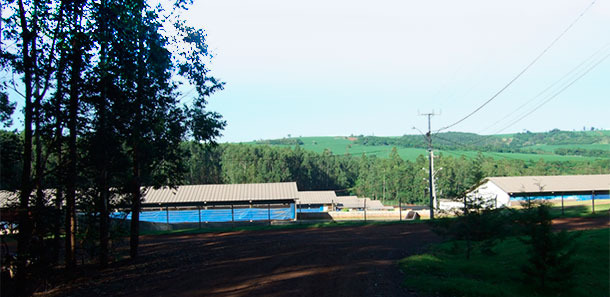Article
Long-distance airborne transport of infectious PRRSV and Mycoplasma hyopneumoniae from a swine population infected with multiple viral variants. Otake S, Dee S,Corzo C, Oliveira S, Deen J. Veterinary Microbiology 145 (2010) 198–208

Article brief
What are they studying?
This study was created to simulate the conditions observed in the field to create a mixed infection of heterologous PRRSV variants together with Mycoplasma hyopneumoniae.
The goal was to evaluate the long-distance airborne transport of these agents out to and beyond 4.7 km and assess their viability in long-distance air samples.
How is it done?
A building that was mechanically ventilated housed 252 grow-finish pigs which served as a source of PRRSV and M. hyo. bioaerosols during 21 days following experimental inoculation with M. hyo. and PRRSV.
To determine airborne transmission of PRRSV and M hyo, an area of 166 km2 with 31 sampling points around the experimental site was selected. There were no other swine facilities within a radius of 16 km and no other sources of contamination, such as the application of manure on fields or transport of pigs during the sampling period.
Air samples were collected every day from different sampling points depending on the direction of the predominant win don that day. Also, a single 30-min air sample from the source population was collected with the same cyclonic collector placed 1m from an exhaust fan located in the source barn.
Each air sample was analyzed with the PCR technique and, if positive for PRRSV or M. hyo., a swine bioassay was performed to confirm infectivity of the isolated specimen. Intramuscular injection was used to assess infectiousness of PRRSV and intratracheal injection was used for M. hyo.
What are the results?
114 long-distance air samples were collected during the 21 days of the study period, and 21 samples were collected from the exhaust fan in the source barn (135 air samples in total). The short-distance air samples were all PRRSV-positive (21 of 21, 100%), while 8 (38%) were M. hyo.-positive.
Out of the 114 long-distance samples collected 5 (4.4%) were PRRSV PCR-positive. The positive samples were taken at 2.3 km, 4.6, 6.6 and 9.1 km from the source population barn. And phylogenetic analysis indicated a high degree of homology (>99.2%) with the source strain.
On the other hand, 6 (5.3%) samples were M. hyo. PCR-positive. Those samples were taken at 3.5, 4.6, 5.2, 6.8, 9.1 and 9.2 km, and had a high degree of homology (99.9%) to the source of M. hyo.
By using a swine bioassay the viability of the recovered PRRSv and M. hyo. samples was confirmed.
What implications does this paper have?
These results prove that long-distance airborne transport of PRRSV and M. hyo. can occur up to 9.2km.
There was a big difference in the concentration of infectious PRRSV recovered from the source population (approximately 4 logs) and the amount found in air samples collected at long distances (approximately 1-2 logs).
The results would have been different in areas with different topography, i.e. dense woodlands or elevated terrain.
|
We have known for many years that M. hyo. can travel long distances by air. It was said to travel up to 3 km in ideal conditions —cold weather, light wind, high humidity and flat ground. This information was known on the basis of epidemiological studies, and is confirmed in this work by presenting evidence that the pathogen can be transmitted over even greater distances, to just over 9 km. It has not always been clear in the case of PRRS. In fact, Scott Dee himself (one of the authors of the work) long defended the difficult airborne transmission of the virus. Today, however, it is accepted that PRRS virus is transmitted by air (some strains more than others), although nobody thought the virus could still be infectious after travelling such long distances (9.1km). The article discusses whether the mixed infection established in the infecting population may have an exacerbating effect of the infection, and therefore facilitate airborne transmission. Either way, it is clear that airborne transmission of both pathogens is a real possibility that needs to be assessed when trying to protect a farm from infection. Considering the results of the work it is clear that, for new farms, the choice of location will be one of the critical points in maintaining the farm free of infection for a long period of time. Obviously, the holding should be away from other pig farms. If on flat ground (such as the example in the article), the distance to neighbouring farms should be more than 10 km. However, if a choice is possible, it would be preferable to settle on uneven ground, if possible with trees to limit the transmission of both pathogens. A decrease in the virus concentrations in the different samples shown in the article, is observed as the distance increases. The more obstacles the virus finds on its path, the shortest the distance it may spread. In countries like Brazil, new farms are protected by surrounding them with a belt of about 100 m of trees (eucalyptus), precisely for this purpose.
But what we can do in those farms that are not ideally located? Measures taken in the US include use of air filtration systems in order to prevent the introduction of pathogens. Filters are an expensive investment, can only be installed on farms with forced ventilation, and are not a full guarantee. Filters reduce the likelihood of infection, but do not make it zero. Another measure that, based on the results of the work we are discussing, would allow to reduce the risk of airborne transmission, is surrounding the farm with a fence of tall hedges.Whereas this measure is frequent in some parts of Europe, in some others it's not even contemplated. If all farms in an area were surrounded by a hedge (obviously of a certain height), that would not only make it difficult for pathogens to leave the farm, but it would also reduce the risk of introduction of pathogens. The combination of both effects would result in a real reduction in the frequency of outbreaks. This type of measures should be considered in areas that have initiated regional control plans, as they could have a real impact with a relatively low investment. In cases where planting a perimeter hedge may not be possible, a perimeter fence breaking the laminar air flow would also help. |










